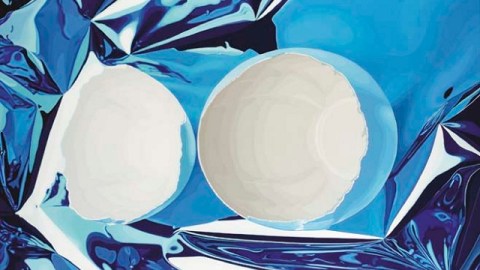How Jeff Koons Cracked a Young Artist’s Dream

Fresh off his potential “Colbert Bump,” conceptual artist Jeff Koons took a potential PR black eye this weekend in a New York Times Magazine piece titled “I Was Jeff Koons’s Studio Serf.” Former painter John Powers tells a short, but harrowing tale of working in the high-pressure studio of “ideas man” Koons. His experience there eventually led to his giving up his dream of painting altogether. If Jeff Koons is the paradigm for today’s major artist and this is roughly the experience young artists working under him garner, then what does that mean for the long-hallowed tradition of the atelier, where artists teach others artists the trade? If a young artist can crack under these modern conditions, is the tradition of the artist-teacher broken?
Powers answered a help-wanted advertisement in 1995 when he was just a 21-year-old art student. Koons’ studio manager reviewed Powers’ slides before conferring with the head painter and giving Powers a $14 per hour position in the studio. Winning this first professional job initially made Powers happy and proud, but things soon turned sour. Dozens of assistants were churning out Koons’ Celebration series of images from a child’s birthday party that are now Koons’ signature pieces: balloon dogs, frosted cakes, etc. The (in)famous, unskilled Koons dreamed up the ideas and left the actual creation to his unknown, but highly skilled assistants. “He was a perfectionist who promptly fired assistants whenever they failed to meet his standards,” Powers writes. “I never had to worry. I’d always had a careful eye and steady hand.”
Powers’ steady hand soon began work on a painting titled Cracked Egg (shown above). A photo of a split eggshell sitting on reflective mylar was projected onto a white 80-square-foot canvas for tracing. Four other painters custom mixed paints to match the colors of the original photo and then coded sections of the drawing with the corresponding colors. “My job was simple: Paint by numbers,” Powers says with ultimate understatement. Sometimes using brushes with bristles “no longer than an eyelash,” Powers had “to hand-fashion a flat, seamless surface that appeared to have been manufactured by machine, which meant there could be no visible brush strokes, no blending, no mistakes.” Koons called for a perfect, mechanical, personless rendering of the original image and would settle for nothing less.
After working for 5 months on Cracked Egg, Powers had nearly finished when the pulley system attached to the canvas failed and the perfect surface was damaged. Nobody blamed the young artist for the accident, but he was just as damaged as the painting. Koons scrapped the original and assigned Powers to do it all over again. “I traced the familiar image of the egg and its thousand jagged reflections by hand, in pencil, still in shock,” Powers remembers. “A few weeks later, I quit.”
The final blow came a year later, when Powers left art school not finishing his degree. “In my final critique, my professors piled into my tiny studio and ripped me to pieces,” Powers confesses. “I’ll admit I had it coming. My work exhibited every bad habit they’d tried and failed to break. It was too tight, too constrained, too controlled. And it was too late to start over.” It may be unfair to say that the experience in Koons’ studio reinforced Powers’ bad habits, but his paint-by-numbers exercise from Hell sounds like the absolute worst assignment for an artist already plagued by tightness, constraint, and control issues. “ I punched out a window on my way out the door,” Powers finishes. I wonder if he imagined Jeff Koons’ face on that window.
There’s a long tradition of young artists working for established artists. During the Renaissance, when church and government commissions overwhelmed big-name stars, they relied on highly skilled assistants to help. While working on the Sistine Chapel Ceiling, Michelangelo, who had been primarily a sculptor up to that point, called upon assistants more familiar with fresco painting. In exchange for their expertise, which Michelangelo quickly assimilated, Michelangelo gave them his prestige by proxy, which helped them find their own commissions. Michelangelo himself started out in the workshop of Domenico Ghirlandaio. After just a year of apprenticeship and just 14 years of age, Michelangelo began earning a wage as an artist in Ghirlandaio’s workshop rather than just taking payment in tutelage. Similarly, Raphael got his start in the workshop of Perugino before making his name and operating his own workshop, whose greatest group effort is perhaps the famous Loggia in the Vatican. Whereas an exchange took place in the apprenticeships of the past that benefitted both parties, it’s hard not to see the way that Koons, Damien Hirst, and other big name contemporary artists use assistants as an unbalanced transaction at best and exploitation at worst.
Powers saves the cruelest “yolk” for last—Cracked Egg, the painting he worked on for months at $14 per hour, sold in 2003 for $501,933, a new record for a painting “by” Koons. No longer a painter, Powers lists himself as a private detective and novelist. Perhaps this revelation is linked to a soon-to-be-released, fictionalized “tell-all” tale of Koons’ workshop by a former insider. I’ve never read a testimonial—good or bad—from Koons’ studio, so it is possible that Powers is exaggerating for personal profit. I’ll keep a close watch for any studio workers who break their silence in Koons’ defense. If Powers’ story is true, however, it’s a sad symbol of just how endangered artistic traditions are today. Where Michelangelo and Raphael once “paid it forward,” artists today such as Koons selfishly keep it for themselves.





